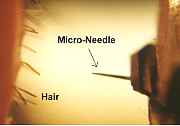Kumetrix is engineering silicon microneedles designed to draw blood and perform chemical measurements. Their micro-needle is about the size of a human hair, as can be seen in the picture below, and has been integrated with a micro-reservoir or cuvette.
Kumetrix approach permits painless testing. The system consists of a hand-held, battery-powered, electronic monitor similar to today's meters, that holds a cartridge loaded with up to 10 disposable sampling devices. Each disposable consists of the micro-needle and a receptacle into which the blood sample is drawn.

To take a measurement, the cartridge is loaded into the monitor and pressed against the skin. This action causes the micro-needle to penetrate the skin and draw a very small volume of blood, 1/100th the size of a drop (100 nanoliters), into the disposable needle. Chemical reagents within the microneedle react with the glucose in the sample to produce a color. The monitor analyzes the color using a laser light and then displays the blood-glucose concentration.
Kumetrix compares the silicon micro-needle to a mosquito bite where the person is unaware of being bitten until, in the case of the mosquito, enzymes injected by the mosquito to thin the blood later cause irritation, redness, and swelling. Kumetrix, thankfully, has refrained from adding the mosquito's irritating enzymes.
The micro-needles are manufactured like computer chips. Kumetrix says it has developed its silicon micro-needle device with less than $3 million in financial support from the State of California, DARPA, the NIH and the National Science Foundation. The company did its initial research at the Class 100 clean room computer chip manufacturing facility at Stanford University. It currently has a licensing agreement with Bayer Diagnostics.
